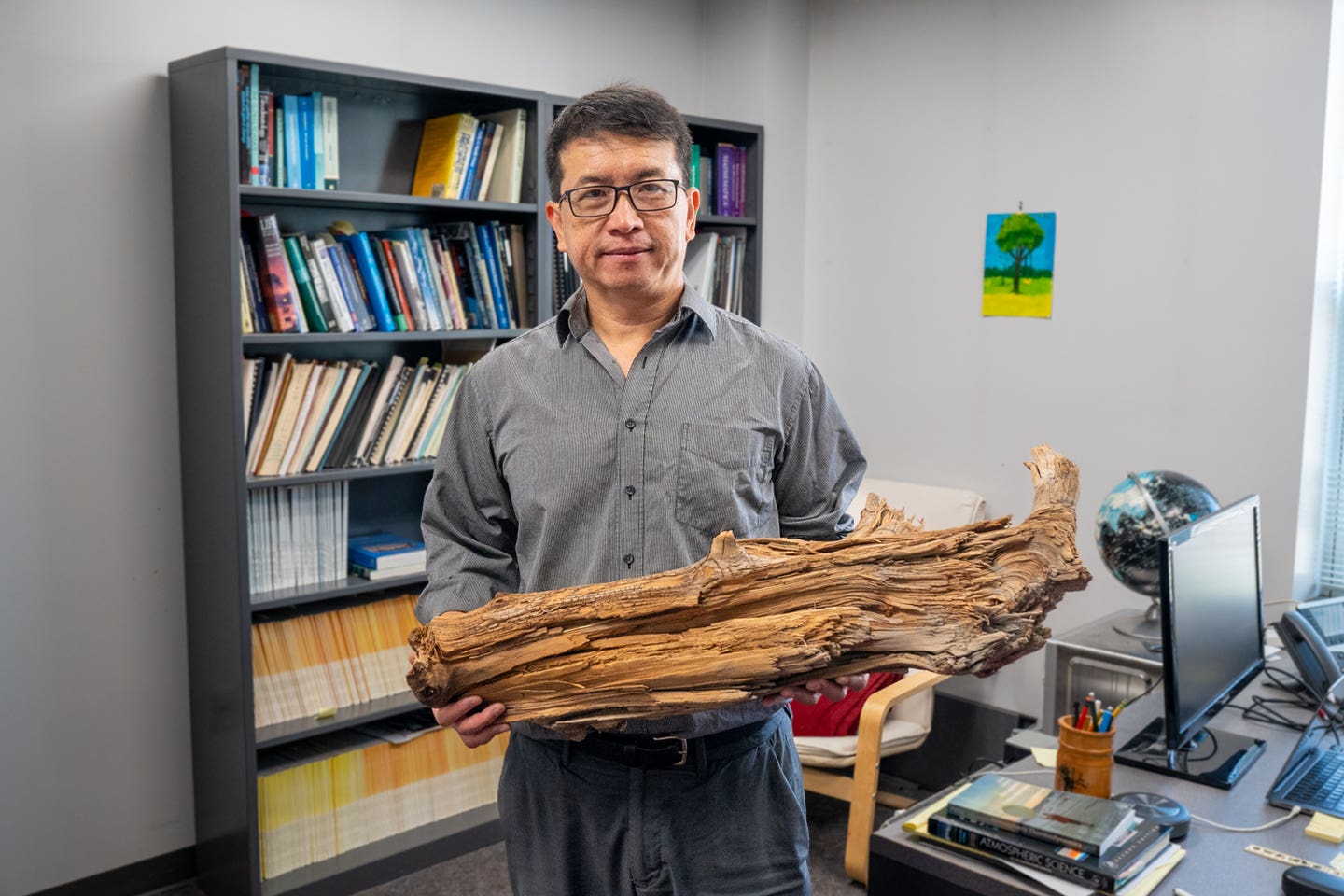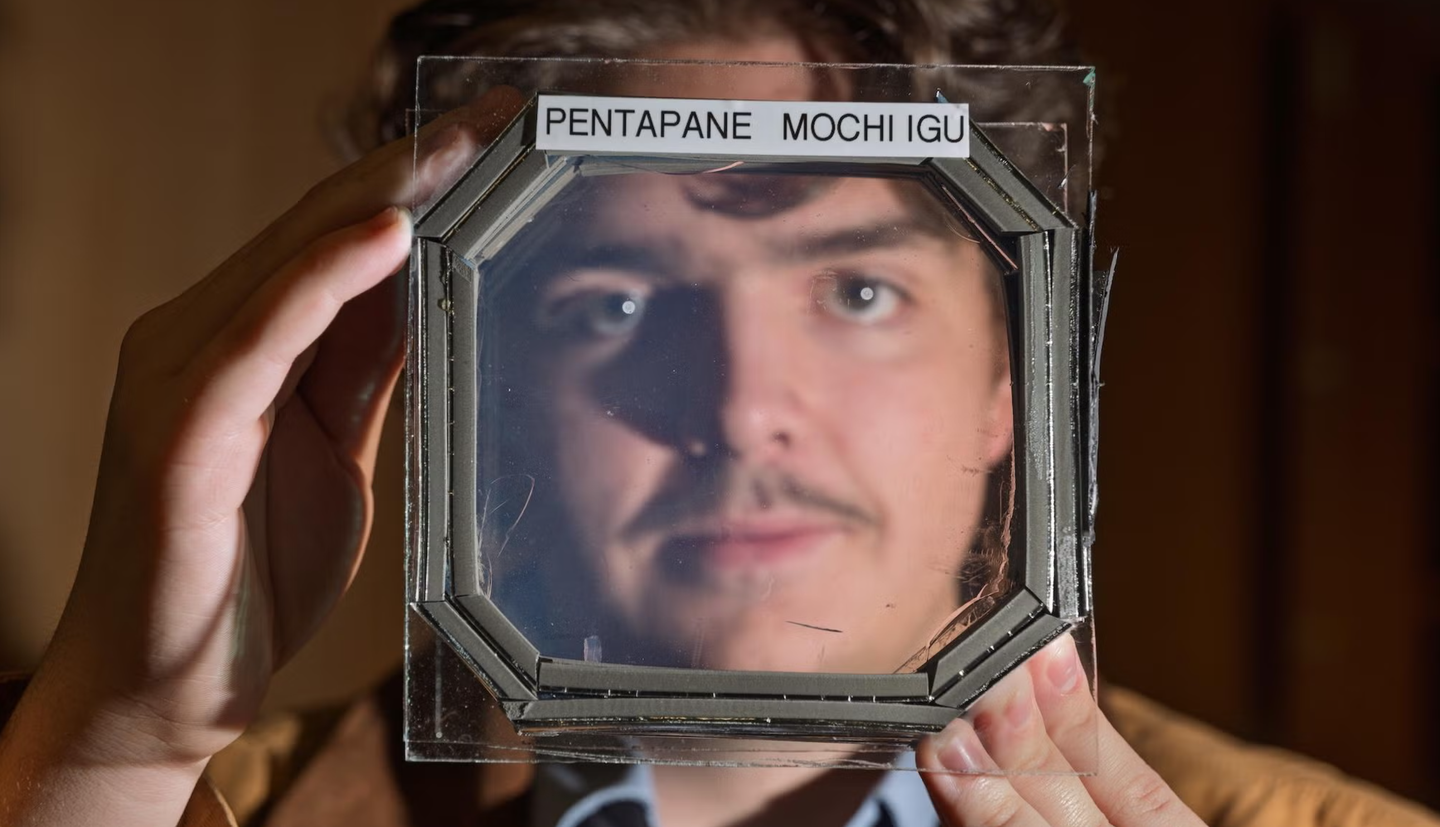3,775-year-old preserved log could revolutionize the fight against climate change
A 3,775-year-old log discovered in Quebec offers new insights into preserving carbon and combating climate change through wood vaulting.

University of Maryland Atmospheric and Oceanic Science Professor Ning Zeng holds the 3,775-year-old log that is the subject of a new study in Science. (CREDIT: Mark Sherwood, University of Maryland)
The recent discovery of a well-preserved ancient log could provide important insights into combating climate change. Researchers led by Professor Ning Zeng from the University of Maryland studied a 3,775-year-old log and its surrounding soil, uncovering key findings about carbon storage.
Published in the journal Science, the study shows that this log retained over 95% of its original carbon content, thanks to the unique properties of the clay soil it was buried in.
This nearly intact log, described by Zeng as being in such good condition that it could potentially be used for furniture, offers clues for refining "wood vaulting" as a climate solution. The process of wood vaulting involves burying non-commercial wood—like diseased trees, fallen forest debris, or old furniture—to prevent decomposition and keep carbon stored.
Trees play a key role in sequestering carbon dioxide, a major greenhouse gas. When trees are alive, they absorb carbon, making reforestation and tree-planting initiatives effective strategies to fight global warming. However, once trees die, their decomposition releases the stored carbon back into the atmosphere, undermining these efforts. Wood vaulting aims to break this cycle by ensuring that dead wood retains its stored carbon rather than releasing it.
“People tend to think, ‘Who doesn’t know how to dig a hole and bury some wood?’” Zeng explained. “But think about how many wooden coffins were buried in human history. How many of them survived? For a timescale of hundreds or thousands of years, we need the right conditions.”
The inspiration for this study began during a wood vaulting project in Quebec, Canada, back in 2013. While digging a trench to bury fresh wood, Zeng and his colleagues unexpectedly unearthed a log from about 6.5 feet below the ground. For Zeng, this discovery felt almost “miraculous.” The log was immediately identified as Eastern red cedar by the ecologists present, who were amazed by its excellent state of preservation.
Related Stories
Zeng recalled that moment vividly: “When the excavator pulled a log out of the ground and threw it over to us, the three ecologists that I had invited from McGill University immediately identified it as Eastern red cedar. You could tell how well it was preserved. I remember standing there thinking, ‘Wow, here’s the evidence that we need!’”
Although previous research had studied well-preserved ancient wood, they often ignored the soil that surrounded it. “There is a lot of geological and archeological evidence of preserved wood from hundreds to millions of years ago, but the focus of those studies was not ‘How we can engineer a wood vault to preserve that wood?’” Zeng said. “And the problem with designing a new experiment is that we can’t wait 100 years for the results.”
After the discovery in Quebec, carbon dating confirmed the log’s age. In 2021, further analysis was conducted by Distinguished University Professor Liangbing Hu from the University of Maryland's Department of Materials Science and Engineering.
Hu and Zeng examined the microscopic structure, chemical makeup, mechanical strength, and density of the log, comparing it to a freshly cut Eastern red cedar. The older log showed minimal carbon dioxide loss, suggesting that the burial conditions significantly slowed down the decomposition process.
The key to this remarkable preservation lay in the type of soil that encased the log. Clay soil, particularly in this part of Quebec, has extremely low permeability, which limited oxygen exposure and kept out decomposers like fungi and insects. These conditions were instrumental in maintaining the carbon content of the wood.
This finding has implications for climate strategies worldwide. Since clay soils are widespread, wood vaulting could serve as a practical, low-cost option for carbon sequestration in many regions.
Zeng suggests that wood vaulting could be one piece of a larger climate strategy, which would also include reducing carbon emissions and other greenhouse gas reduction methods. By keeping wood from decomposing, wood vaulting can help minimize carbon release into the atmosphere, complementing broader climate efforts.
“It’s quite an exciting discovery,” Zeng commented. “The urgency of climate change has become such a prominent issue, so there was even more motivation to get this analysis going.”
The researchers are already looking forward to the next steps in optimizing wood vaulting practices. This means testing and implementing techniques that can be used on a broader scale to store carbon effectively. Zeng's work highlights the potential of seemingly simple solutions when applied with the right scientific insight.
Climate change remains an urgent global issue, and while technologies like carbon capture and alternative energy are being developed, simpler methods like wood vaulting could also play a key role. By focusing on the natural carbon-storing capabilities of trees and finding ways to keep that carbon locked away, the research adds another valuable tool to combat climate change.
The concept of wood vaulting is especially compelling because it leverages what nature already provides—wood. By ensuring that even dead wood does not become a source of emissions, this approach could make a significant contribution to global climate solutions. As Zeng and his team work to refine these methods, the hope is that wood vaulting can be scaled up and integrated into broader environmental policies.
Incorporating soil characteristics, particularly the use of low-permeability clay, will be vital for this approach. The Quebec log serves as proof that, with the right conditions, wood can remain preserved for thousands of years without releasing its carbon back into the atmosphere. Understanding these factors will help make wood vaulting a feasible, scalable method for carbon sequestration.
The study also brings to light the importance of applying knowledge from unexpected findings. In this case, a lucky discovery during a pilot project led to a breakthrough that could help in the fight against climate change. Moments of serendipity like this are not uncommon in science, where chance and curiosity often drive new ideas forward.
For Zeng and his colleagues, the 3,775-year-old log in Quebec may just be the key to making wood vaulting a reliable climate strategy.
Note: Materials provided above by The Brighter Side of News. Content may be edited for style and length.
Like these kind of feel good stories? Get The Brighter Side of News' newsletter.



